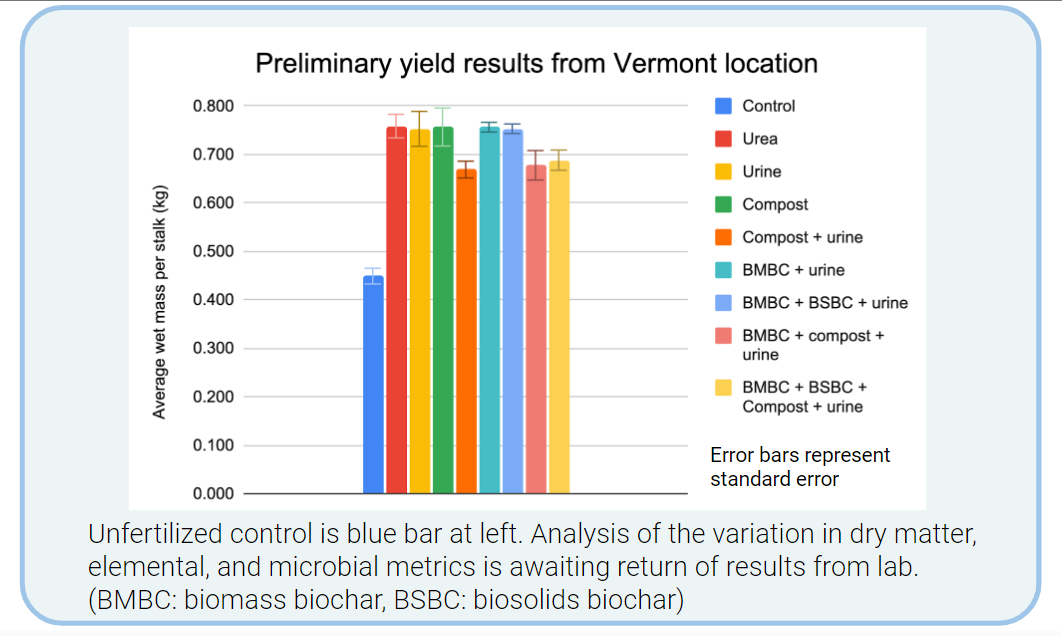Progress report for LNE22-453R
Project Information
This research will investigate a novel approach to meeting the identified farmer needs of reducing energy-intensive agricultural inputs, participating in sustainable nutrient cycling, and promoting soil health. Our approach aims to accomplish these goals through the reclamation of human waste as fertilizer, in the form of biosolids-derived biochar and source separated human urine. Producing biochar from biosolids offers an opportunity to convert a waste into a value-added product that can increase soil organic matter in soils, help mitigate climate change, and improve crop production, while reducing the need for additional external inputs. The benefits of biochar are known to be enhanced further when biochar has been charged/incolulated/blended with nutrient rich materials before use, such as urine-derived fertilizer. Thus, using both the solid and liquid human waste products could be a way to reduce the need for external synthetic fertilizers and use both forms of waste simultaneously.
Our project will evaluate the potential for adoption of these novel human waste-derived soil amendments through a 3-year field experiment measuring the effect of these amendments on soil health, and through social research on farmer attitudes and perceptions.
The field experiment, using corn, will examine how combinations of source-separated human urine, biomass biochar, and biosolids biochar affect soil health, crop yield, and nutrient leaching, compared to currently-used conventional and organic amendments. We will use the following nine treatments: Control (no amendments); Urea; Urine; Compost; Compost + urine; Biomass biochar + urine; Biosolids biochar + urine; Biosolids biochar + urine (with annual reduced-rate biochar application); and Compost + biosolids biochar + urine.
The social research component builds on our previous SARE projects, which documented strong farmer interest in and adoption of source-separated human urine as fertilizer. However, we also identified concerns about urine related to potential soil health effects from residual pharmaceuticals, and concerns about biosolids related to microcontaminants, organic pollutants, and heavy metals. The use of biosolids biochar combined with urine may allay these farmer concerns, because the high-temperature conversion of biosolids to biochar eliminates many organic contaminants and immobilizes heavy metals. Furthermore biochar has been shown to immobilize organic contaminants, such as the residual pharmaceuticals in urine. Our goal will be to understand farmer perceptions of biosolids biochar, a novel amendment, and determine what further research or best practices may be required for this product to be adopted by farmers in the Northeast. Social research will include 20 farmer interviews, a regional survey, and farm field days.
This research will investigate opportunities to meet identified farmer needs to reduce energy-intensive agricultural inputs, participate in sustainable nutrient cycling, and promote soil health, through the reclamation of human waste as fertilizer in the form of biosolids-based biochar and source separated human urine. We will investigate their soil health effects in comparison to conventional and organic amendments, including wood-derived biochar. We will conduct social research with farmers to understand their perceptions of biosolids biochar, a novel amendment, and determine what further research or best practices may be required for this product to be adopted by farmers in the Northeast.
Cooperators
- (Researcher)
- (Researcher)
Research
An Advisory Committee (AC) was formed and met for the first time April 7, 2022 to review the project as a whole, solicit advisory committee recommendations on the research goals and plan, and go over advisory committee member roles and responsibilities. The group helped to solidify remaining aspects of the experimental design, a process which has been ongoing through conversations with individual members in their areas of expertise. We also consulted with AC members on selecting farmers to interview and review and make recommendations for the interview guide. Due to the untimely death of Marshall Webb, and another initial AC member who is no longer available, we have now recruited two new AC members. The AC met for a second time on March 3rd, 2023 to discuss plans for the upcoming field season. The next meeting of the AC will occur in February or early March 2024.
The current AC is as follows:
Tom Beaudry, Certified Crop Advisor, NH. Owner/operator Elm Island, Farm, Walpole, NH. Serves on VT Nutrient Management Commission. Works with over 20,000 acres with
management plans in New England. Expertise assisting farmers use nutrients effectively.
Joshua Allen, VT Soil Conservationist and State Outreach Coordinator, NRCS, Brattleboro Field office. Program Manager for NRCS LGBT Program.
Thomas Akin - Conservation Agronomist with NRCS, VT.
Johannes Lehmann, Professor, School of Integrative Plant Science, Cornell University.
Focuses on soil carbon properties and cycles, biochar, nutrient recycling, and sustainable agriculture. Directs the Cornell pyrolysis kiln and leads a related research project on manure derived biochar.
Rachel Thiet, Director of Conservation Biology, Environmental Studies & Sustainability,
Antioch University. Interdisciplinary social science background as well as disciplinary
training in plant and soil ecology.
Bradley Kennedy, PhD Student, College of Agriculture and Natural Resources, University of Maryland. Former research associate at Rich Earth, currently pursuing a PhD in agricultural nitrogen management.
Ryan Lertora, Farmer/Manager, Jamesport Farmstead, Jamesport, NY, a 50-acre organic
vegetable farm on the North Fork of Long Island. Worked for 5 years on a farm in Maine
before moving to Long Island to run his own operation.
Katherine von Stackelberg, Senior Research Scientist, Harvard Center for Risk Analysis, and farmer, permaculture orchard, Ecodale Farm in Vermont. Also has a consulting company, NEK Associates LTD, that works on different projects on environmental science issues.
Farmer Engagement
We received IRB approval through Cornell University for the social research component of the project. We have identified a range of farmers to interview and with whom to conduct site visits in New York and have contacted most of these farmers. We are currently in the process of identifying the New England farmers to include in the project. We developed an interview protocol (see link below) for these interviews, and have conducted two of these so far. We intend to conduct the the rest of these interviews this winter and through the second year of the project, as farmers are available. The first two interviews were conducted by Zoom. Some of the others will be conducted in person and will include site visits.
SARE 2022 draft interview guide revised 5.26.22
Hypothesis
We hypothesize that there are positive effects on soil health and crop yield through using biochar and soluble fertilizer combinations in comparison to their use alone. We anticipate that these benefits can be achieved using two recycled amendments: source-separated urine and biosolids biochar. Our project will evaluate the potential for adoption of these novel human waste-derived soil amendments through investigating:
- How urine, biomass biochar, and biosolids biochar affect soil health, compared to currently-used conventional and organic amendments.
- The questions, concerns, and recommendations of farmers, including specific indicators of soil health they consider important with respect to the tested amendments.
Materials & Methods
SOIL HEALTH
Field trials are being conducted: 1) in Brattleboro, VT, on a working farm, and 2) at the Cornell University Long Island Horticultural Research and Extension Center in Riverhead, NY. Urine used in the study is pasteurized to meet Class A biosolid standards and sourced from near Brattleboro, Vermont. Urine used in LI is shipped from Vermont.
We originally intended to conduct the first season of the field trial in 2022, but due to the short period of time between funding of the grant and the beginning of the field season, we determined that this was not feasible. We therefore focused on planning and procurement of materials in 2022, and conducted the first field trial in 2023. We collected baseline soil health samples in Fall 2022.
Treatments
Corn will be grown in nine treatments, selected to include a range of soluble and organic forms of nitrogen, along with labile (quick-to-decompose) organic carbon, recalcitrant (slow-to-decompose) organic carbon, or negligible levels of organic carbon. The treatments are listed below, in numerical order, and then in a table to show their distribution along two axes representing different forms of carbon and nitrogen:
Treatment
- Control (no amendments)
- Urea
- Urine
- Compost
- Compost + urine
- Biomass biochar + urine
- Biosolids biochar + urine
- Annual biosolids biochar + urine
- Compost + biosolids biochar + urine
|
Organic carbon characteristics |
|||||
|
Labile |
Labile and recalcitrant |
Mostly recalcitrant |
None/ negligible |
||
|
Nitrogen characteristics |
Soluble |
Biochar + urine (#6,7,8) |
Urea (#2) Urine (#3) |
||
|
Soluble and organic |
Compost + urine (#5) |
Compost + biochar + urine (#9) |
|||
|
Mostly organic |
Compost (#4) |
||||
This design allows evaluation of the multi-year effect of applying labile carbon paired with organic nitrogen, compared to primarily recalcitrant carbon paired with soluble nitrogen. Intermediate treatments contain a combination of both types of nitrogen and carbon, to examine synergistic effects. The two low-to-no-carbon fertilizers and the control offer fertilized and unfertilized comparisons to the high-carbon treatments. The experiment also directly compares biomass biochar and biosolids biochar. The annual biosolids biochar+urine treatment tests smaller biochar additions co-applied with urine each year.
Amendment application rates for all treatments (except the control) will be calculated to meet the corn’s agronomic N needs. Supplemental P and K will be added if indicated by soil tests. Combination treatments using both urine and compost will receive equal amounts of N from each amendment. Compost will be applied as a broadcast before tilling. Urine and urea will be split between a planting application and mid-season sidedress, and applied 2-3” below the soil surface and 4-6” away from the corn row.
Biomass biochar will be produced from Southern Yellow Pine pyrolyzed at 800°C, and biosolids biochar will be pyrolized at 600°C. Biochar will be charged by mixing with compost or urine 1-2 weeks before surface application in Year 1. For the annual biochar treatment, biochar will be mixed with urine and applied each year at planting time. Biochar application rates will be chosen in consultation with Advisory Committee members.
Methods
Two field experiments were established, one on Long Island and one in Vermont, both using a randomized complete block design. Each plot contains 45 subplots, to accommodate five replicates of nine treatments. Subplots measure 20’ long x 12’ wide, containing four rows of corn. Sampling occurred within the center 16’ of the middle two rows.
The following steps are being followed at both locations:
Before season 1:
Baseline soil health and nutrient samples were collected to represent the entire study field and sent to the Cornell Soil Health Lab for analysis.
During each of the three growing seasons:
- Terminate winter rye cover crop using herbicide.
- Surface apply compost and charged biochar to appropriate treatments.
- Till the entire field.
- Plant corn.
- Apply synthetic fertilizer and urine treatments using standard practices: 2-3” below the soil and 4-6” away from each row.
- At mid-season, test leaf chlorophyll levels using a SPAD meter, and sample soil for pre-sidedress nitrogen testing (PSNT) on all subplots
- Side-dress corn with the remaining N using appropriate fertilizer source for that treatment. (we did not use the PSNT or SPAD results to determine sidedress N rates but instead just applied the remaining N as determined by the treatment.
- Collect yield data: biomass and silage analysis.
- Collect soil nutrient samples on all subplots.
After season 3:
Collect soil health samples from each subplot in Spring 2025.
Soil health testing will be done using Cornell’s Comprehensive Assessment of Soil Health (CASH) test. Soil health samples provide information on a soil’s physical, chemical, and biological properties, allowing for more holistic or systems thinking approaches to management. Samples will be collected at the start of the trials (Spring 2022) and end of the trials (Spring 2025) at both locations. Concurrently, longer-term microbial analyses will be conducted if separate funding is secured.
Lysimeters will be installed at the Long Island project location to collect data on nitrogen leaching from the different treatments. Samples will be sent to an outside lab for total nitrogen analysis.
Data will be analyzed using appropriate statistical methodology and statistical significance between treatments will be assessed at the 5% significance threshold. Results will be disseminated through the final report, farmer field days, conferences, and at least one article for the peer reviewed literature and one for trade literature. (See "Farmer Outreach" section above for specific journals to be targeted.)
Season 1 Update:
In mid-April, baseline soil samples were collected from each of 45 subplots in both VT and LI plots and submitted for amplicon sequencing (Cornell University, NY) and phospholipid fatty acid (PLFA) analysis (Soil Health Assessment Center, Columbia, MO). This was done using funding from the Foundation for Food & Agriculture Research for conducting an add-on component to this study examining impacts of the treatments on soil microbiology.
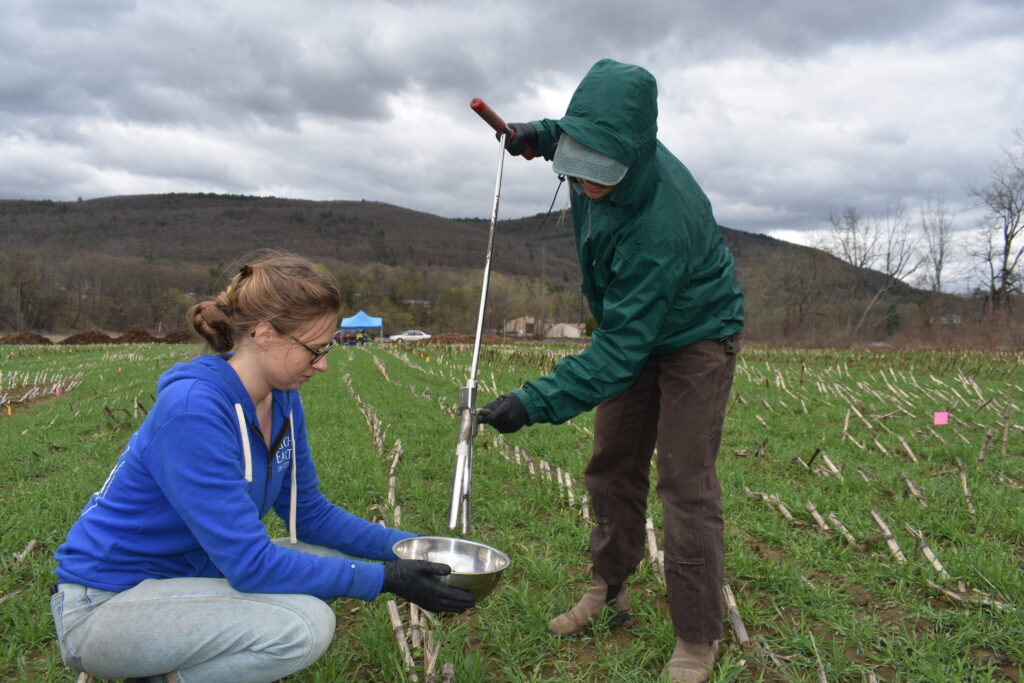
In late April, compost, TSP and KCl fertilizer supplements, and biochar amendments were applied to subplots according to the treatments detailed above. Compost (sourced from Vermont Compost Co.) was distributed evenly from a 5-gallon bucket to each plot, the boundaries of which were marked with a 20’ x 12’ subplot grid. TSP and KCl amendments were applied to subplots using a hand-pushed fertilizer cart or by hand at the LI site. Biochar amendments were weighed into 5-gallon buckets and mixed with urine in a 1:1 ratio to “charge” the biochar one week prior to application. Charged biochar was applied to field plots by evenly dispersing it from the 5-gallon buckets over the subplot grid.
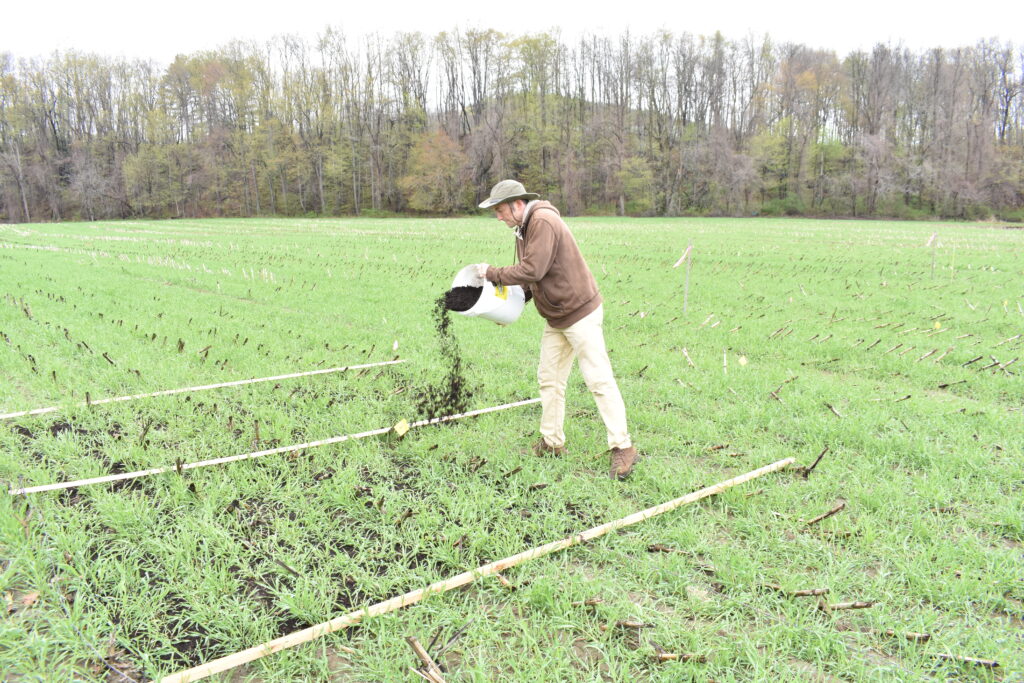
The field was tilled and planted with corn in mid-May. When seedlings emerged in late May, the first of two applications of urine and synthetic urea amendments were applied to their respective treatments. Both urine and urea were applied to furrows (2” deep and 2” from seedlings) and covered with a rake following application. Urine was applied evenly to each furrow using a hand-held applicator similar to a watering can. Urea was applied by shaking pellets evenly into furrows from a container.
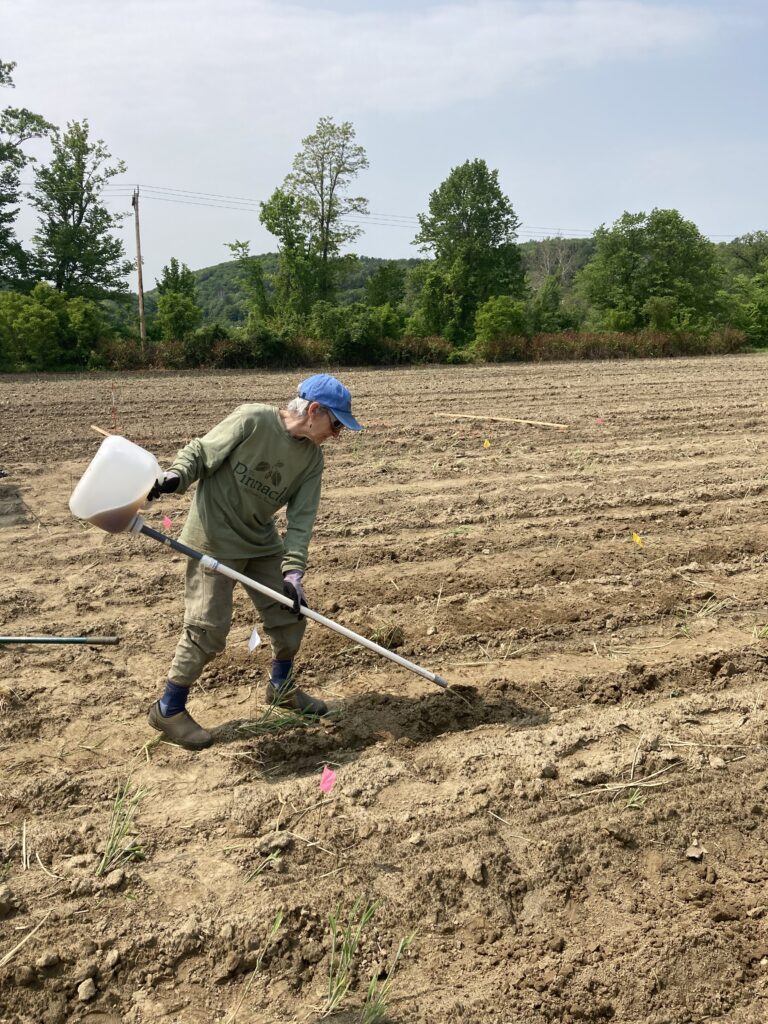
In late June, Pre-Sidedress Nitrate Testing (PSNT) and SPAD testing was performed in each subplot. PSNT soil samples were sent to DairyOne Labs for analysis, and results from both PSNT and SPAD analysis indicated low nitrate availability. Sidedress urine and urea applications were applied to respective treatments using the methods from the prior application, with furrows (2” deep and 6” from plants) on both sides of a corn row to account for the larger volume of urine applied at this time.
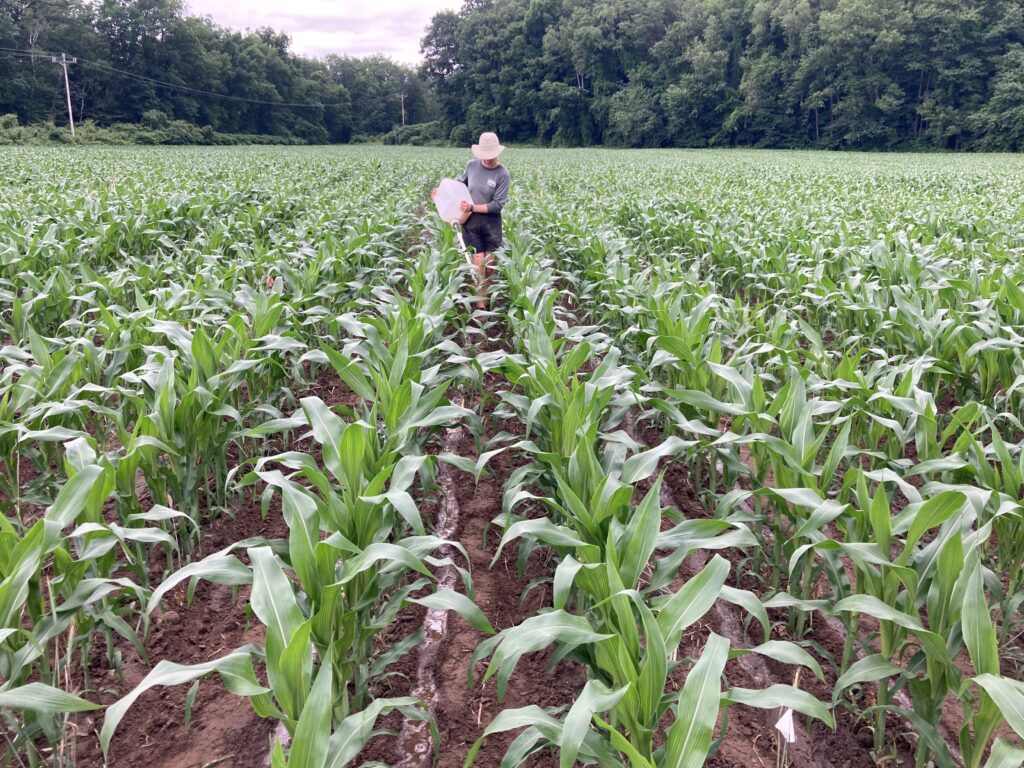
In mid-September, the corn of each subplot was harvested and the wet weight recorded. A subsample of shredded stalk and leaf material was sent to DairyOne Labs for forage analysis. For eight ears in each subplot, variables of 1) ear length, 2) length of ear with developed kernels, and 3) the number of kernel rows were measured and recorded.
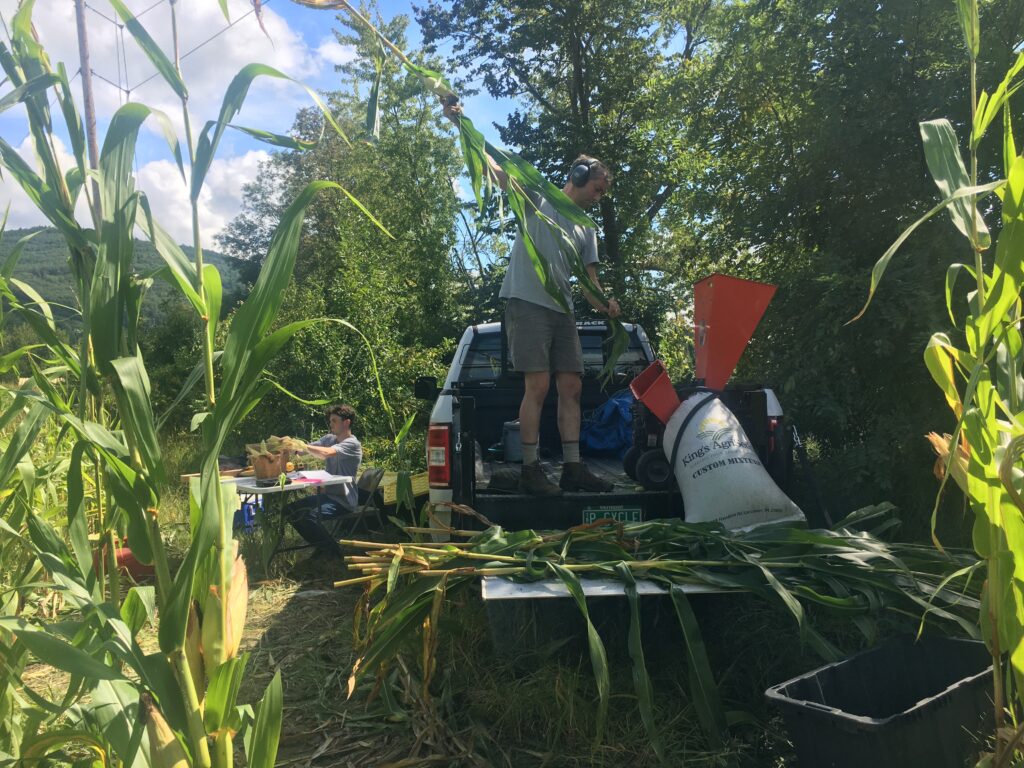

Social Research
Our social research aims to understand farmer perspectives on the novel amendments studied in this project. We will analyze farmers' questions, concerns, and identify opportunities for and barriers to adoption (including economic factors) to inform our research and education strategies. To accomplish this, we propose an iterative farmer engagement process, creating opportunities for participation through interviews, small dialogue groups at field days, and a regional survey.
Years 1 & 2
Interviews are to be conducted with 20 farmers (10 in VT and 10 in NY) to identify opportunities for implementation and future research needs. With Advisory Committee help, we are selecting farmers representing a diversity of operations, with specific effort to include farmers who currently use biochar or biosolids (or have demonstrated interest in such use), as well as BIPOC and women-owned enterprises. Interviews include current nutrient management practices; decision making about farm/soil management; ideas/concerns about the novel amendments of this study; suggestions for both consumer oriented and farmer-to-farmer educational materials; and soil health information needs. Interviews are being recorded, transcribed, and will be coded for analysis, using standard triangulation protocols for qualitative research. (Saldana, 2016) Results from our interview analysis will be used to inform the ongoing research plan.
Year 3
A farmer survey will be disseminated to farmers across the Northeast region through networks identified in the Farmer Engagement section above. The survey will be used to gather perspectives on the potential adoption of the tested amendments, including barriers, opportunities, and outstanding questions. The survey will introduce preliminary results compiled from field trials and interviews, and solicit additional recommendations for educational materials.
We will also host a field day at each test site (one in NY and one in VT) to share study results with farmers, agricultural educators, and others and gather participants' feedback, questions and concerns. We will provide educational materials to share with farmers, informed by prior social and technical results, and facilitate break-out groups to discuss and evaluate the educational materials and their potential adaptation for different purposes. (See Steps to Adoption section above).
Data from the interviews, survey, and the small group conversations will be analyzed for dissemination via conferences, the final report, and articles for both trade literature and peer-reviewed journals. (See "Farmer Outreach" section above for specific journals.)
Year 1 Social Research Update: Approximately 13 farmers in New York State and 6 in New England have been identified as potential interviewees for this project. Most of these have been contacted at least once, but follow up contacts will be made shortly. Additional New England potential interviews are still being identified. Two interviews in New York State have been conducted. The social research for this project has been delayed somewhat due to Tatiana Schreiber's family medical leave for periods of time during 2023. We will be therefore be conducting the bulk of these interviews now through the winter of 2024.
This project is in its early stages and there are no research conclusions to report at this time.
Learning Outcomes
Advisory Committee members met twice and learned about the project and the potential benefits and risks of biochar created from biosolids.
Project Outcomes
This project is still in early stages and there are no success stories to report at this time.
This project is in its early stages and there has not been an assessment of project approach at this time.
